26 February 2006
Panama Canal Zone, Balboa Yacht Club N 08.56.147 W 079.33.306
Through the Ditch
|
Fun Facts
- If all the rock and dirt dug from the canal were piled into boxcars, the resulting train would circle the earth four times at the equator.
- No pumps are used to raise and lower ships in the locks; it is all done by gravity.
- The lock chambers are 110 feet wide. The widest ship to have transited the canal is the USS New Jersey with a beam of 108 feet.
- The lock chambers are 1,000 feet long. The longest ship to have transited the canal was the San Juan Prospector with a length of 973 feet.
- Ninety two percent of the world's ocean-going ships still transit the canal.
- The United States is the major user of the canal.
- The largest toll paid to transit the canal was $273,750 paid by the Coral Princess in 2003. The smallest toll paid to transit was $.36 by Richard Halliburton in 1928 to swim the canal. No one else has ever been allowed to do this as it is too dangerous.
- The record for most transits on a single day, 65, was set on February 29, 1968.
- The average transit takes 8 - 10 hours.
- The fastest transit time, 2 hours and 41 minutes, was set by the U. S. Navy hydrofoil Pegasus.
- A ship traveling from New York to San Francisco saves 7,872 miles by using the canal instead of going around the tip of South America.
|
At two-thirty in the morning we boarded the catamaran Gato Go along with one other couple and pushed away from the Panama Yacht Club dock. We motored out the channel to the anchorage, better known as the flats, where we circled for over two hours waiting for our advisor to join the crew and head through the canal along with seven other small craft. Typically the ACP, the Panama Canal Authority, allows one small craft through the canal per day and that boat will lock up with a major tanker or freighter. But at this time of year small craft are stacked up on the Caribbean side in order to make the transit just as the hurricane season is receding in the Pacific. Not only are there many individual cruising boats waiting to transit but also an organized flotilla of thirty boats called the Blue Water Rally. This group is organized by Jimmy Cornell an icon in the cruising community who writes prolifically and organizes events such as these. Jimmy offers a program that ushers boats on a circumnavigation in twenty months and for this service and coordination and the comfort of traveling with a group you pay $15,000. Oh yea, you also get two cocktail parties and one T-shirt. We opted to pass up the organized events for our westward journey.
So the canal authority has pushed through about nine or more cruising boats a day and will continue to do so until the log jam is broken. This gave us the opportunity to act as line handlers and to gain experience that 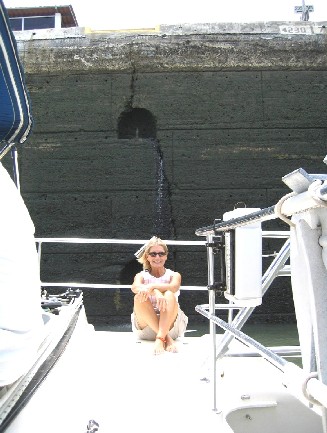 we may need when we take Shiraz through. The job of line handlers consist of manning the four corners of a boat with 125 foot lines to help ease the boat up or down in the locks as the case may be and hopefully keep the boat in the middle of the lock and off the rough cement walls. The job is not one to be taken lightly as the water rushing in or out of the canal can cause turbulence requiring close attention and sometimes a strong tug for the two hours of up and two hours of down in the three locks. we may need when we take Shiraz through. The job of line handlers consist of manning the four corners of a boat with 125 foot lines to help ease the boat up or down in the locks as the case may be and hopefully keep the boat in the middle of the lock and off the rough cement walls. The job is not one to be taken lightly as the water rushing in or out of the canal can cause turbulence requiring close attention and sometimes a strong tug for the two hours of up and two hours of down in the three locks.
The trip for boats under 50 feet cost $600 and you must also put up security deposit of $850. It seems doubtful that a small boat under 50 feet could possibly do any damage to the canal with its 7 foot thick doors but rules are rules. After you apply for transit your boat is measured and then you go to the bank to pay. Later that evening you may call to find out what your transit date will be and on that date an advisor is boarded on your boat to guide you through the process. The waiting period can take anywhere from one to three weeks. The transit itself can take 12 hours if you are heading west to east and usually one and a half days if heading east to west (actually the canal run north and south but that's too confusing for this website). This includes an overnight mooring in Gatun Lake. Because the authorities were trying to clear the boats from Colon and the Jimmy Cornell group was there, we did the east to west all in one day.
In 1903 the US signed a treaty with the Colombian government to build a canal in the providence of Panama. The treaty failed to be ratified by the Colombian parliament and shortly thereafter a separatist movement declared independence fearing the US would build a canal in Nicaragua. The US immediately recognized Panama and sent warships to protect the newly founded nation. At the direction of the new government a treaty was drafted and signed by the French administrator of the prior canal effort, you no doubt remember that a French company tried to build a canal in the 1880's but eventually filed bankruptcy. The treaty allocated a ten mile wide strip for the canal and any other land the US wanted in perpetuity. It allowed the US to interfere with Panamanian affairs to protect its interest in the Canal which necessitated more than a dozen military bases in the Canal Zone. Although the treaty was redrafted several times through the years, this one-sided agreement became more and more contentious until in 1964 Panamanian students attempted to raise the Panamanian flag in the Canal Zone which was for all intents and purposes sovereign US territory. The effort resulted in the death of 20 or so Panamanians and "Remembrance Day" is today celebrated as a national holiday in Panama. It was in fact Gerald Ford that laid the ground work to turn the Canal over to the Panamanians. President Ford believed we were facing another Vietnam if in fact we didn't come to grips with our "up handed" treatment surrounding the Canal and the Panamanians. Jimmy Carter was of course tagged with giving away the canal. It was by then militarily indefensible and with the troops needed to put up the appearance of security it was a drain on US resources.
Well enough history.
Shiraz was first scheduled to transit about three days after we arrived in Colon but this was not enough time for us as we had just ordered parts from the US so we sought a later date and the ACP 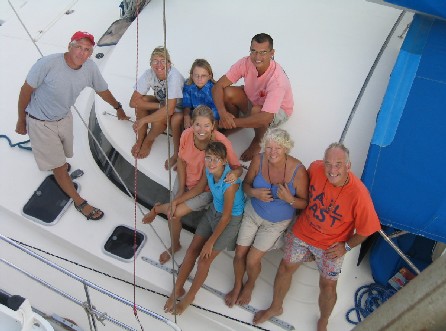 scheduled us for the 26th of February. With this extra time we undertook the process of lowering the waterline on the boat. This occurs when you go to the supermarket for days-on-end and spend about $400.00 per trip. You see we have been reading about the South Pacific and from what we understand food is very expensive. A bag of chips can cost over $5.00 and there seems to be a complete lack of Cheese Curls. And what about paper products? We have 85 rolls of toilet paper on board and I promise Rene I would get her some when we arrived at the other side of the canal. Well, we don't plan to go without anything and it will take us over six months to arrive in New Zealand. Then there is the fuel situation. What will diesel cost and will we be able to get our propane tanks refilled easily ? For every hundred pounds we put onboard the boat sinks a little deeper into the water. We are now at the point that even with no wind we can limp across the Pacific and neither of us would lose a pound. By the time we reach Tonga the boat will be able to sail again. It all makes you wonder how Thor Heyerdahl provisioned for a crew of six aboard Kon Tiki when he sailed his balsa wood boat from Peru to the Polynesian islands in 1947 to prove his theory of migration. I believe DNA test have proven the theory incorrect even thought the voyage was successful. I guess Thor had it easier since he was not been weaned to Coke-a-Cola and didn't have refrigeration. scheduled us for the 26th of February. With this extra time we undertook the process of lowering the waterline on the boat. This occurs when you go to the supermarket for days-on-end and spend about $400.00 per trip. You see we have been reading about the South Pacific and from what we understand food is very expensive. A bag of chips can cost over $5.00 and there seems to be a complete lack of Cheese Curls. And what about paper products? We have 85 rolls of toilet paper on board and I promise Rene I would get her some when we arrived at the other side of the canal. Well, we don't plan to go without anything and it will take us over six months to arrive in New Zealand. Then there is the fuel situation. What will diesel cost and will we be able to get our propane tanks refilled easily ? For every hundred pounds we put onboard the boat sinks a little deeper into the water. We are now at the point that even with no wind we can limp across the Pacific and neither of us would lose a pound. By the time we reach Tonga the boat will be able to sail again. It all makes you wonder how Thor Heyerdahl provisioned for a crew of six aboard Kon Tiki when he sailed his balsa wood boat from Peru to the Polynesian islands in 1947 to prove his theory of migration. I believe DNA test have proven the theory incorrect even thought the voyage was successful. I guess Thor had it easier since he was not been weaned to Coke-a-Cola and didn't have refrigeration.
As we prepared for our own transit we called every few days to check the schedule and on our final call on the 25th, we were informed that the new transit date would be the 2nd of March. 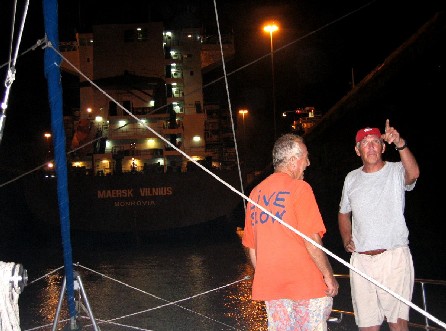 Our line handlers could accommodate the change so it really didn't present a problem to us and we now had a few more days to breath in the toxic fumes belching from the incinerator located next to the marina and to buy more food and paper products, we have now surpassed 100 rolls. Everyday we wash the boat and the next day it is covered with a black soot that we track all over the boat. I wouldn't suggest staying at PCYC unless the water was free. There is a new marina, Shelter Bay, now opened across the canal at the old location of Fort Sherman just inside the breakwater. We understand this marina is much nicer than PCYC but much more expensive especially for catamarans since they expect a 1.4 multiplier for multihulls. We did the math and they were twice as expensive and they are very remote. It cost $8.00 for a taxi to Colon. It is $1.00 from PCYC. The hailing channel on the Caribbean side is 74.and both marinas also monitor this channel. Our line handlers could accommodate the change so it really didn't present a problem to us and we now had a few more days to breath in the toxic fumes belching from the incinerator located next to the marina and to buy more food and paper products, we have now surpassed 100 rolls. Everyday we wash the boat and the next day it is covered with a black soot that we track all over the boat. I wouldn't suggest staying at PCYC unless the water was free. There is a new marina, Shelter Bay, now opened across the canal at the old location of Fort Sherman just inside the breakwater. We understand this marina is much nicer than PCYC but much more expensive especially for catamarans since they expect a 1.4 multiplier for multihulls. We did the math and they were twice as expensive and they are very remote. It cost $8.00 for a taxi to Colon. It is $1.00 from PCYC. The hailing channel on the Caribbean side is 74.and both marinas also monitor this channel.
Everyone with ACP was very professional and helpful. Some cruisers opt to hire an agent to do all of their paperwork for them and for that the agent charges a couple hundred dollars. We opted to keep the cash in the bank and do the leg work ourselves. Everything went fine. People who had paid an agent were pushed back 10 to 14 days and boy were they pissed. They were French flagged boats and hadn't got the hang of "manyana". The agent doesn't schedule the transits he only takes your money. The canal is near capacity today since the US economy is picking up and west coast ports are at capacity.
Transit day finally arrived and there were three boats in our group. It is a requirement that each boat have an advisor so the three of them decided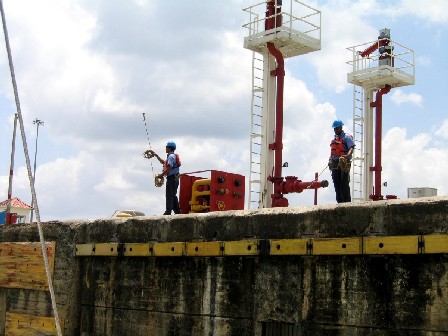 to raft the boats together to go through the locks. This saves water and effort since we were now one larger boat. The largest boat, La Cumbre, was in the center and we were rafted to his starboard and a mono hull, Towanda, a Norwegian boat, to his port. Our evenings agenda is to get all three boats to a mooring in Gatun Lake for mid-night. Gatun Lake is 85 feet above sea level so we will go through three locks to lift us even with the lake. As expected the raft goes through the locks with a large freighter. The large vessels are attached with steel cables that are controlled by powerful electric locomotives, called mules. The mules pull the ships steadily through the canal. For we smaller craft, the canal line handlers throw light lines with a "monkey fist" on the end for added weight. We protected our solar panels with foam and we duck for cover so as not to be hit. We then attach these lines to our heavy125 foot lines which are pulled up to the top of the canal and secured. The lines were rented from an entrepreneurial taxi drivers in Colon who can also provide tires covered in garbage bags for additional fenders. It is dark by now but the locks are well lit. At each lock the lines are walked to the next. We will go through three locks to get to the lake level and as water enters the locks our line handlers have to make sure the line are taut at all times. With three boats tied together it can be heavy work and there is not a lot of leeway for error. Although it is getting late it is all too exciting to be sleepy. to raft the boats together to go through the locks. This saves water and effort since we were now one larger boat. The largest boat, La Cumbre, was in the center and we were rafted to his starboard and a mono hull, Towanda, a Norwegian boat, to his port. Our evenings agenda is to get all three boats to a mooring in Gatun Lake for mid-night. Gatun Lake is 85 feet above sea level so we will go through three locks to lift us even with the lake. As expected the raft goes through the locks with a large freighter. The large vessels are attached with steel cables that are controlled by powerful electric locomotives, called mules. The mules pull the ships steadily through the canal. For we smaller craft, the canal line handlers throw light lines with a "monkey fist" on the end for added weight. We protected our solar panels with foam and we duck for cover so as not to be hit. We then attach these lines to our heavy125 foot lines which are pulled up to the top of the canal and secured. The lines were rented from an entrepreneurial taxi drivers in Colon who can also provide tires covered in garbage bags for additional fenders. It is dark by now but the locks are well lit. At each lock the lines are walked to the next. We will go through three locks to get to the lake level and as water enters the locks our line handlers have to make sure the line are taut at all times. With three boats tied together it can be heavy work and there is not a lot of leeway for error. Although it is getting late it is all too exciting to be sleepy.
Seeing the water enter the lock is pretty incredible. 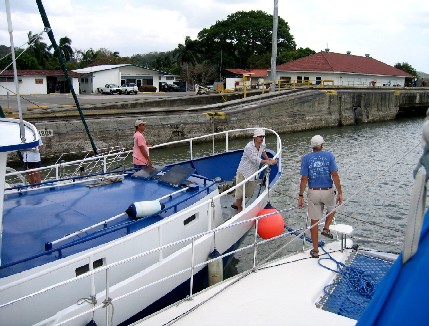 It enters and leaves each lock through a system of pipes, which connect to 100 holes in the floor of each chamber. It takes 52 million gallons of fresh water fed by gravity from Gatun Lake to lift the ships to lake level. All went smoothly and our group of boats moored in the lake around 9:00 p.m. We had a wonderful meal, a few glasses of wine and a few hours of sleep before our journey began again. It enters and leaves each lock through a system of pipes, which connect to 100 holes in the floor of each chamber. It takes 52 million gallons of fresh water fed by gravity from Gatun Lake to lift the ships to lake level. All went smoothly and our group of boats moored in the lake around 9:00 p.m. We had a wonderful meal, a few glasses of wine and a few hours of sleep before our journey began again.
You needn't set an alarm where we were moored since the howling monkeys started well before dawn to establish their territory . The roar they put up would match any stadium at a big ten foot ball game when a touch down was scored.. The sound echoed through the jungle and then another troupe would answer. You could hear the howling work its way up the lake and then down again. This went on for at least three quarters of an hour. It was as close as we came to a Jane Goodall experience (yea I know these are monkeys not chimpanzees). At 5:30 the lights came on in Shiraz and the coffee started perking. Egg casserole was in the oven and everyone was up and ready when the advisors boarded around 7:00. The boats were separated and we all began to make our way across the lake to the locks of Pedro Miguel locks the boats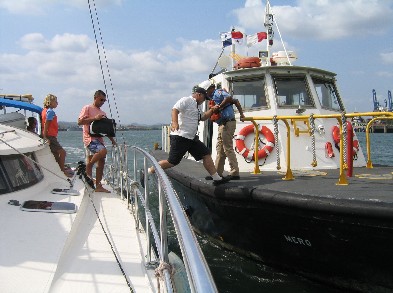 are once again rafted to enter the lock and we go through the process of steadying our group of boats by first keeping the lines tight. As the water leaves the locks and we are lowered the line handlers on board have to release the lines in accordance with the water level. If the lines get slack, the turbulence pushes the raft of boats toward the wall. All engines are running and ours called upon from time to time to help maneuver the group. We are lowered 31 feet to the Miraflores Lake. We cross this small lake as a group but are delayed by more important traffic. We realize that the $1800.00 dollars we collectively paid pales by comparison to the $100, 000.00 or more paid by major ships and cruise liners. By the time we reached the cameras at the Milafolres locks it was close to 3:00 instead of 12:00 which was the time we gave our family to look for us on the pan canal website. Finally we enter the Miraflores Locks, and are lowered 54 feet to the level of the Pacific Ocean. Once outside the last lock we separate the boats, the advisor leaves the vessel, and we motor under the Bridge of the Americans into the Bay of Panama. We are all tired but feel a great sense of accomplishment as we tie Shiraz to the mooring. We greatly appreciate the work and help provided by our line handlers. Bruce, April, Kendal and Quincy Winship from S/V Chewbacca are long time friends all the way back to Cartagena and new found friends, Mike and Jill Windel from S/V Altair a UK flagged boat, who volunteered just for the experience of crossing the canal. Thanks again and we hope you had a great time. are once again rafted to enter the lock and we go through the process of steadying our group of boats by first keeping the lines tight. As the water leaves the locks and we are lowered the line handlers on board have to release the lines in accordance with the water level. If the lines get slack, the turbulence pushes the raft of boats toward the wall. All engines are running and ours called upon from time to time to help maneuver the group. We are lowered 31 feet to the Miraflores Lake. We cross this small lake as a group but are delayed by more important traffic. We realize that the $1800.00 dollars we collectively paid pales by comparison to the $100, 000.00 or more paid by major ships and cruise liners. By the time we reached the cameras at the Milafolres locks it was close to 3:00 instead of 12:00 which was the time we gave our family to look for us on the pan canal website. Finally we enter the Miraflores Locks, and are lowered 54 feet to the level of the Pacific Ocean. Once outside the last lock we separate the boats, the advisor leaves the vessel, and we motor under the Bridge of the Americans into the Bay of Panama. We are all tired but feel a great sense of accomplishment as we tie Shiraz to the mooring. We greatly appreciate the work and help provided by our line handlers. Bruce, April, Kendal and Quincy Winship from S/V Chewbacca are long time friends all the way back to Cartagena and new found friends, Mike and Jill Windel from S/V Altair a UK flagged boat, who volunteered just for the experience of crossing the canal. Thanks again and we hope you had a great time.
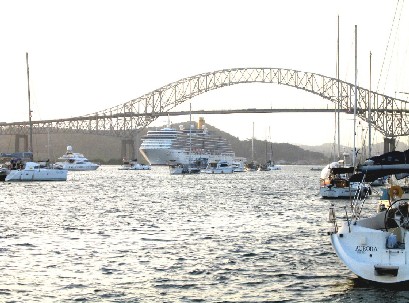
We are now at Balboa and moored near the bridge which is highlighted in blue lights in the early evening. The anchorage is very rolly due to the large vessels entering and departing the canal at all hours. But hey we're in the Pacific and almost ready to go. We were too beat to open the champagne we saved for the occasion and we were in our bunk at a very early hour.
We wake up to the 19.5 feet of tidal range in Balboa which is a dramatic change from the half a foot in Colon. We have been told by a budding oceanographer, our son-in-law, Brian, that this dramatic change is due to the strong North Pacific current that literally pushes the water up against North and Central America. This dramatic change is something that we will need to become accustom to when anchoring in the Pacific.
To view more pictures of our Canal Transit just click on the arrow to start the slide show and the square to stop. We hope that you enjoy them.
Adios Panama!
Back Next
|